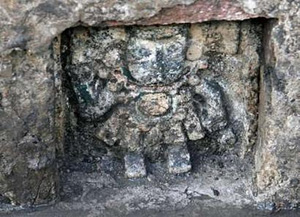 |
 |
 |
 News Around the Republic of Mexico | October 2006 News Around the Republic of Mexico | October 2006  
Mexican Archeologists Make Major Aztec Find
 Gunther Hamm - Reuters Gunther Hamm - Reuters


| | A part of an altar at the Aztec empire's main Templo Mayor temple shows a frieze of the rain god Tlaloc. (Reuters/Tomas Bravo) |
Mexican archeologists have made the most significant Aztec find in decades, unearthing a 15th century altar and a huge stone slab at a ruined temple in the throbbing heart of Mexico City.

The works were uncovered last weekend at the Aztec empire's main Templo Mayor temple, near the central Zocalo square, which was used for worship and human sacrifice.

It was the most meaningful find since electricity workers stumbled upon an eight-tonne carving of an Aztec goddess at the same site in 1978.

"It is a very important discovery, the biggest we have made in 28 years. It will allow us to find out a lot more," Mexico City's mayor, Alejandro Encinas, said on Wednesday.

The altar has a frieze of the rain god Tlaloc and an agricultural deity.

Archeologists are still unearthing the 11-foot (3.5-m) monolith, which they think might be part of an entrance to an underground chamber.


| | A part of an uncovered altar shows a frieze of an agricultural deity at the Aztec empire's main Templo Mayor temple. (Reuters/Tomas Bravo) |
At the site, excavators with pick axes and shovels hacked at the earth above the monolith while groups of archeologists, government officials and reporters waited around the deep pit.

"The importance of the monolith is what we are going to discover...It's likely that it is part of a chamber, of some offering. We won't know until we get close. First we have to get the stone out," said Alberto Diaz, a member of the archeological team.

The Aztecs, a warlike and deeply religious people who built monumental works, ruled an empire stretching from the Gulf of Mexico to the Pacific Ocean and encompassing much of modern-day central Mexico.

Their often bloody reign began in the 14th century and ended when they were subjugated in 1521 by the Spanish led by Hernan Cortes.

TALE OF THREE CITIES

The Aztecs began building the Templo Mayor pyramid-shaped temple in 1375. Its ruins are now only yards from downtown's choking traffic.

The temple was a center of human sacrifice. At one ceremony in 1487, historians say tens of thousands of victims were sacrificed, their hearts ripped out.

Spanish conquistadors destroyed the temple when they razed the city and used its stones to help build their own capital.

Now the site is surrounded by Spanish colonial buildings like Mexico City's cathedral and the historical National Palace as well as convenience stores and fast-food restaurants.

"Really, when we begin to excavate, we realize that we are in three different times, three different cities: You see the current city, the colonial city and the pre-Hispanic city," said Diaz. | 
 | |
 |



